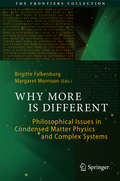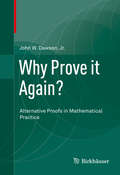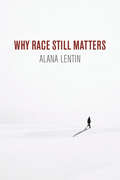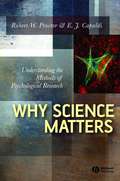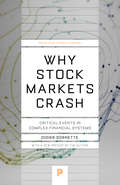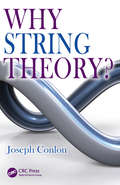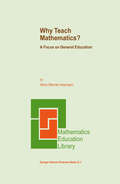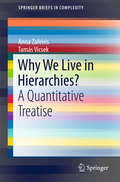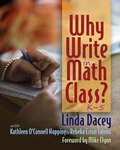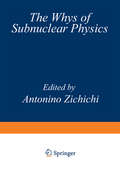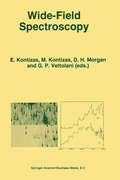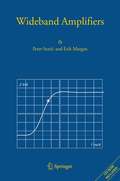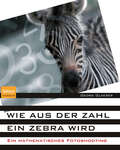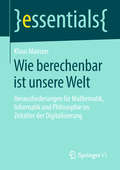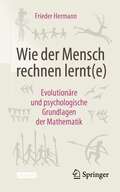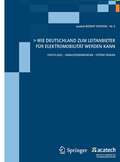- Table View
- List View
Why More Is Different: Philosophical Issues in Condensed Matter Physics and Complex Systems (The Frontiers Collection)
by Brigitte Falkenburg Margaret MorrisonThe physics of condensed matter, in contrast to quantum physics or cosmology, is not traditionally associated with deep philosophical questions. However, as science - largely thanks to more powerful computers - becomes capable of analysing and modelling ever more complex many-body systems, basic questions of philosophical relevance arise. Questions about the emergence of structure, the nature of cooperative behaviour, the implications of the second law, the quantum-classical transition and many other issues. This book is a collection of essays by leading physicists and philosophers. Each investigates one or more of these issues, making use of examples from modern condensed matter research. Physicists and philosophers alike will find surprising and stimulating ideas in these pages.
Why Prove it Again?: Alternative Proofs in Mathematical Practice
by John W. Dawson, Jr.This monograph considers several well-known mathematical theorems and asks the question, “Why prove it again?” while examining alternative proofs. It explores the different rationales mathematicians may have for pursuing and presenting new proofs of previously established results, as well as how they judge whether two proofs of a given result are different. While a number of books have examined alternative proofs of individual theorems, this is the first that presents comparative case studies of other methods for a variety of different theorems.The author begins by laying out the criteria for distinguishing among proofs and enumerates reasons why new proofs have, for so long, played a prominent role in mathematical practice. He then outlines various purposes that alternative proofs may serve. Each chapter that follows provides a detailed case study of alternative proofs for particular theorems, including the Pythagorean Theorem, the Fundamental Theorem of Arithmetic, Desargues’ Theorem, the Prime Number Theorem, and the proof of the irreducibility of cyclotomic polynomials.Why Prove It Again? will appeal to a broad range of readers, including historians and philosophers of mathematics, students, and practicing mathematicians. Additionally, teachers will find it to be a useful source of alternative methods of presenting material to their students.
Why Race Still Matters
by Alana Lentin'Why are you making this about race?' This question is repeated daily in public and in the media. Calling someone racist in these times of mounting white supremacy seems to be a worse insult than racism itself. In our supposedly post-racial society, surely it’s time to stop talking about race? This powerful refutation is a call to notice not just when and how race still matters but when, how and why it is said not to matter. Race critical scholar Alana Lentin argues that society is in urgent need of developing the skills of racial literacy, by jettisoning the idea that race is something and unveiling what race does as a key technology of modern rule, hidden in plain sight. Weaving together international examples, she eviscerates misconceptions such as reverse racism and the newfound acceptability of 'race realism', bursts the 'I’m not racist, but' justification, complicates the common criticisms of identity politics and warns against using concerns about antisemitism as a proxy for antiracism. Dominant voices in society suggest we are talking too much about race. Lentin shows why we actually need to talk about it more and how in doing so we can act to make it matter less.
Why Science Matters: Understanding the Methods of Psychological Research
by Robert W. Proctor E. J. CapaldiWhy Science Matters: Understanding the Methods of Psychological Research rises above standard research methods texts by presenting an up-to-date view of contemporary psychological science as it is currently understood and practiced. Explores not only the procedural aspects of psychological research, but also delves into the issue of how to accomplish effective science. Explicates how hypotheses and theories are to be evaluated. Suggests that the proper approach to devising and evaluating theories is by abduction, not by induction or deduction alone. Incorporates new investigatory procedures, current methodologists, conflicts and issues, implications of the philosophy of science, and a lively prose style. Provides a picture of science that will engage students and expand their abilities as both scientists and psychologists.
Why Stock Markets Crash: Critical Events in Complex Financial Systems
by Didier SornetteThe scientific study of complex systems has transformed a wide range of disciplines in recent years, enabling researchers in both the natural and social sciences to model and predict phenomena as diverse as earthquakes, global warming, demographic patterns, financial crises, and the failure of materials. In this book, Didier Sornette boldly applies his varied experience in these areas to propose a simple, powerful, and general theory of how, why, and when stock markets crash. Most attempts to explain market failures seek to pinpoint triggering mechanisms that occur hours, days, or weeks before the collapse. Sornette proposes a radically different view: the underlying cause can be sought months and even years before the abrupt, catastrophic event in the build-up of cooperative speculation, which often translates into an accelerating rise of the market price, otherwise known as a "bubble." Anchoring his sophisticated, step-by-step analysis in leading-edge physical and statistical modeling techniques, he unearths remarkable insights and some predictions--among them, that the "end of the growth era" will occur around 2050. Sornette probes major historical precedents, from the decades-long "tulip mania" in the Netherlands that wilted suddenly in 1637 to the South Sea Bubble that ended with the first huge market crash in England in 1720, to the Great Crash of October 1929 and Black Monday in 1987, to cite just a few. He concludes that most explanations other than cooperative self-organization fail to account for the subtle bubbles by which the markets lay the groundwork for catastrophe. Any investor or investment professional who seeks a genuine understanding of looming financial disasters should read this book. Physicists, geologists, biologists, economists, and others will welcome Why Stock Markets Crash as a highly original "scientific tale," as Sornette aptly puts it, of the exciting and sometimes fearsome--but no longer quite so unfathomable--world of stock markets.
Why Stock Markets Crash: Critical Events in Complex Financial Systems
by Didier SornetteThe scientific study of complex systems has transformed a wide range of disciplines in recent years, enabling researchers in both the natural and social sciences to model and predict phenomena as diverse as earthquakes, global warming, demographic patterns, financial crises, and the failure of materials. In this book, Didier Sornette boldly applies his varied experience in these areas to propose a simple, powerful, and general theory of how, why, and when stock markets crash. Most attempts to explain market failures seek to pinpoint triggering mechanisms that occur hours, days, or weeks before the collapse. Sornette proposes a radically different view: the underlying cause can be sought months and even years before the abrupt, catastrophic event in the build-up of cooperative speculation, which often translates into an accelerating rise of the market price, otherwise known as a "bubble." Anchoring his sophisticated, step-by-step analysis in leading-edge physical and statistical modeling techniques, he unearths remarkable insights and some predictions--among them, that the "end of the growth era" will occur around 2050. Sornette probes major historical precedents, from the decades-long "tulip mania" in the Netherlands that wilted suddenly in 1637 to the South Sea Bubble that ended with the first huge market crash in England in 1720, to the Great Crash of October 1929 and Black Monday in 1987, to cite just a few. He concludes that most explanations other than cooperative self-organization fail to account for the subtle bubbles by which the markets lay the groundwork for catastrophe. Any investor or investment professional who seeks a genuine understanding of looming financial disasters should read this book. Physicists, geologists, biologists, economists, and others will welcome Why Stock Markets Crash as a highly original "scientific tale," as Sornette aptly puts it, of the exciting and sometimes fearsome--but no longer quite so unfathomable--world of stock markets.
Why String Theory?
by Joseph ConlonPhysics World's 'Book of the Year' for 2016 An Entertaining and Enlightening Guide to the Who, What, and Why of String Theory, now also available in an updated reflowable electronic format compatible with mobile devices and e-readers. During the last 50 years, numerous physicists have tried to unravel the secrets of string theory. Yet why do these scientists work on a theory lacking experimental confirmation? Why String Theory? provides the answer, offering a highly readable and accessible panorama of the who, what, and why of this large aspect of modern theoretical physics. The author, a theoretical physics professor at the University of Oxford and a leading string theorist, explains what string theory is and where it originated. He describes how string theory fits into physics and why so many physicists and mathematicians find it appealing when working on topics from M-theory to monsters and from cosmology to superconductors.
Why String Theory?
by Joseph ConlonPhysics World's 'Book of the Year' for 2016 An Entertaining and Enlightening Guide to the Who, What, and Why of String Theory, now also available in an updated reflowable electronic format compatible with mobile devices and e-readers. During the last 50 years, numerous physicists have tried to unravel the secrets of string theory. Yet why do these scientists work on a theory lacking experimental confirmation? Why String Theory? provides the answer, offering a highly readable and accessible panorama of the who, what, and why of this large aspect of modern theoretical physics. The author, a theoretical physics professor at the University of Oxford and a leading string theorist, explains what string theory is and where it originated. He describes how string theory fits into physics and why so many physicists and mathematicians find it appealing when working on topics from M-theory to monsters and from cosmology to superconductors.
Why Teach Mathematics?: A Focus on General Education (Mathematics Education Library #33)
by H.W. HeymannIn this book, the author discusses a modern concept of general education that then helps to clarify both curricular and pedagogical deficits involved in conventional mathematics instruction. It provides an outline of an alternative mathematics instruction that can help to realize a general education and presents detailed arguments for seven interconnected objectives of a school system aiming at general education.
Why We Live in Hierarchies?: A Quantitative Treatise (SpringerBriefs in Complexity)
by Anna Zafeiris Tamás VicsekThis book systematically interprets and documents new, unifying principles and basic laws describing the most relevant aspects of hierarchy. To do so, it discusses recent experiments and models that are simple and realistic enough to reproduce the observations, and develops concepts for a better understanding of the complexity of systems consisting of many organisms. The book covers systems ranging from flocks of birds to groups of people. Although it focuses on hierarchical collective behavior in general, two aspects pop up in the majority of cases: collective motion and dynamically changing, partially directed networks (and the natural relation between the two). In addition, it offers a brief description of the most relevant definitions and concepts involved in the context of hierarchies, presenting both a review of the current literature and a number of new experimental and computational results in more detail. It is a valuable resource for students and scholars pursuing research on the structure of interactions within the collectives of animals and humans.
Why Write in Math Class?
by Linda Dacey Rebeka Eston Salemi Kathleen O'Connell HoppingTo help students communicate their mathematical thinking, many teachers have created classrooms where math talk has become a successful and joyful instructional practice. Building on that success, the ideas in Why Write in Math Class? help students construct, explore, represent, refine, connect, and reflect on mathematical ideas. Writing also provides teachers with a window into each student's thinking and informs instructional decisions.Focusing on five types of writing in math (exploratory, explanatory, argumentative, creative, and reflective), Why Write in Math Class? offers a variety of ways to integrate writing into the math class. The ideas in this book will help you make connections to what you already know about the teaching of writing within literacy instruction and build on what you've learned about the development of classroom communities that support math talk.The authors offer practical advice about how to support writing in math, as well as many specific examples of writing prompts and tasks that require high-cognitive demand. Extensive stories and samples of student work from K-5 classrooms give a vision of how writing in math class can successfully unfold.
Why Write in Math Class?
by Linda Dacey Rebeka Eston Salemi Kathleen O'Connell HoppingTo help students communicate their mathematical thinking, many teachers have created classrooms where math talk has become a successful and joyful instructional practice. Building on that success, the ideas in Why Write in Math Class? help students construct, explore, represent, refine, connect, and reflect on mathematical ideas. Writing also provides teachers with a window into each student's thinking and informs instructional decisions.Focusing on five types of writing in math (exploratory, explanatory, argumentative, creative, and reflective), Why Write in Math Class? offers a variety of ways to integrate writing into the math class. The ideas in this book will help you make connections to what you already know about the teaching of writing within literacy instruction and build on what you've learned about the development of classroom communities that support math talk.The authors offer practical advice about how to support writing in math, as well as many specific examples of writing prompts and tasks that require high-cognitive demand. Extensive stories and samples of student work from K-5 classrooms give a vision of how writing in math class can successfully unfold.
The Whys of Subnuclear Physics (The Subnuclear Series #15)
by Antonio L. ZichichiFrom 23 July to 10 August 1977 a group of 125 physicists from 72 laboratories of 20 countries met in Erice to attend the 15th Course of the International School of Subnuclear Physics. The countries represented at the School were: Belgium, Bulgaria, Denmark, Federal Republic of Germany, Finland, France, Hungary, Ireland, Israel, Italy, Japan, the Netherlands, Norway, Poland, Sweden, Switzerland, the United Kingdom, the United States of America and Venezuela. The School was sponsored by the Italian Ministry of Public Education (MPI), the Italian Ministry of Scientific and Technologi cal Research (MRST) , the North Atlantic Treaty Organization (NATO), the Regional Sicilian Government (ERS) and the Heizmann Institute of Science. The School was very exciting due to the impressive number of frontier problems which were discussed. Being the 15th year of the School, it was decided to review all outstanding "Whys". At various stages of my work I have enjoyed the collaboration of many friends whose contributions have been extremely important for the School and are highly appreciated. I would like to thank Dr.A. Gabriele, Ms.S. McGarry, Mr. and Mrs. S. Newman, Ms.P. Savalli and Ms.M. Zaini for the general scientific and administrative work. Finally, I would like to thank most warmly all those ~n Erice, Bologna and Geneva who helped me on so many occasions and to whom I feel very much indebted.
Wide-Field Spectroscopy: Proceedings of the 2nd Conference of the Working Group of IAU Commission 9 on “Wide-Field Imaging” held in Athens, Greece, May 20–25, 1996 (Astrophysics and Space Science Library #212)
by E. Kontizas M. Kontizas D. H. Morgan G. P. VettolaniE. KONTIZAS Astronomical Institute National Observatory of Athens P. O. Box 20048 Athens GR-1181O GREECE The international conference on "Wide-Field Spectroscopy" and its sub ject matter were agreed during the general assembly of the International Astronomical Union (IAU) in August 1994 by the Working Group of Com mision 9 "Wi de-Field Imaging". This meeting gave an opportunity to world experts on this subject to gather in Athens, in order to discuss the cur rent exploitation and the impending opportunities that exist in the area of multi-object spectroscopy, with particular emphasis on: 1. Astronomical instruments, data acquisition, processing and analysis techniques. 2. Astrophysical problems best tackled through wide-field, multi-object spectroscopy. The new fibre optic technology offers an important tool for the advancement of basic research and the development of industrial applications. Astronom ical spectroscopy is a field of astronomy which has contributed much to the advancement of fundamental physics. The spectra of hot stars have been used to determine the well-known Balmer formula for the wavelength of hydrogen lines, in the late 19th century. Since then, spectroscopy has made enormous progress in stellar atmosphere studies, in kinematics, and in the detection of high redshifts in the Universe. The traditional techniques of obtaining wide-field spectroscopic data are based on slitless spectroscopy (objective prism). Several observations, world wide, make use ofthese tech niques in order to obtain information on the spectral properties of objects in large areas of the sky.
Wideband Amplifiers
by Peter Staric Erik MarganThis work covers two bases, both performance optimization strategies and a complete introduction to mathematical procedures required for a successful circuit design. It starts from the basics of mathematical procedures and circuit analysis before moving on to the more advanced topics of system optimization and synthesis, along with the complete mathematical apparatus required. The authors have been at pains to make the material accessible by limiting the mathematics to the necessary minimum.
Wie aus der Zahl ein Zebra wird: Ein mathematisches Fotoshooting
by Georg GlaeserWas haben ein Zebra, eine Hartkoralle und ein Tigerhai gemeinsam, und was trocknender Schlamm, Libellenflügel und Blattstrukturen? Kann man aufgrund von Fotografien nachweisen, dass unser Mond eine Kugel ist? Wie kommt es zu den seltsamen Verzerrungen der "Sonnenscheibe" beim Auf- und Untergang? Was ist ein Schneckenkönig und gibt es auch einen Röhrenwurmkönig? Welche Kurven sind die einzigen, welche die fotografische Abbildung ohne Wesensänderung verkraften? Sehen Fische so wie wir durch ein Fischaugenobjektiv? Welche geometrischen Eigenschaften eines Objekts haben "physikalische Konsequenzen"? Warum irisieren Seifenblasen? Woher kommen die tänzelnden Regenbogenmuster, die man beim abendlichen Schnorcheln im Flachwasser zu sehen bekommt? Ab welcher Höhe und wie stark sieht man die Erdkrümmung? Welche geometrischen Muster stellen sich bei Interferenz von Wellen ein? Was ist so faszinierend, wenn elliptische Räder aufeinander rollen? Mathematiker mit einem Hang zur Biologie, Physik, Geografie, Astronomie, Architektur, Design usw. und einer stets bereiten Fotokamera in der Hand sehen die Welt ein bisschen anders und stellen dann recht unorthodoxe Fragen: In diesem Buch gibt es 144 Doppelseiten mit mindestens ebenso vielen Fragestellungen dieser Art. Das Prinzip, ein Problem anzugehen, ist oft ähnlich: Zunächst gibt es ein in irgendeiner Hinsicht bemerkenswertes Foto. Darum rankt sich ein kurzer Erklärungstext, der neugierig macht und Lösungen anbietet, dann Literaturangaben (insbesondere einschlägige Internet-Links), die man zwecks Vertiefung zu Rate ziehen kann. Fast immer ist auch eine dazu passende Computersimulation zu sehen, um das Gesagte noch anschaulicher zu machen oder zu erhärten.
Wie berechenbar ist unsere Welt: Herausforderungen für Mathematik, Informatik und Philosophie im Zeitalter der Digitalisierung (essentials)
by Klaus MainzerKlaus Mainzer legt in diesem essential dar, dass die Zukunft von KI und Digitalisierung eine nüchterne Analyse erfordert, die Grundlagenforschung mit Anwendung verbindet. Berechenbarkeits- und Beweistheorie können dazu beitragen, Big Data und Machine Learning sicherer zu bewältigen. Dabei zeigt sich, dass die komplexen Herausforderungen der digitalen und analogen Welt in Grundlagenfragen der Mathematik, Informatik und Philosophie tief verwurzelt sind.
Wie der Mensch rechnen lernt(e): Evolutionäre und psychologische Grundlagen der Mathematik
by Frieder HermannWarum kann jeder Mensch aber kein Tier lernen mit exakten Zahlen zu rechnen? Und warum hat sich die mathematische Begabung des Menschen im Verlauf der Evolution überhaupt herausgebildet? In seinem spannend und auch für Nichtexperten leicht lesbaren Überblick skizziert der Mathematiker Frieder Hermann den derzeitigen Stand unseres Wissens über diese Fragen. Er stellt nicht nur mehrere konkurrierende Theorien vor, sondern auch viele faszinierende psychologische Experimente. Das Themenspektrum reicht von Platons Gedankenexperiment über die mathematischen Fähigkeiten eines ungebildeten Sklaven bis hin zu neuesten Erkenntnissen der Autismus-Forschung.
Wie Deutschland zum Leitanbieter für Elektromobilität werden kann: Statuts Quo - Herausforderungen - Offene Fragen (acatech BEZIEHT POSITION)
by Acatech Acatech Deutsche Akademie Der TechnikwissenschaftenNach den Plänen der Bundesregierung sollen bis zum Jahr 2020 eine Million Elektrofahrzeuge auf Deutschlands Straßen fahren und die Bundesrepublik zu einem internationalen Leitmarkt werden lassen. Welche Hürden gilt es dabei zu nehmen, damit Deutschland nicht nur zu einem Leitmarkt, sondern auch zu einem internationalen Leitanbieter von marktfähiger Elektromobilität wird? Welcher Zeithorizont ist dabei realistisch? In welchen Feldern bestehen für den Forschungs- und Technologiestandort Möglichkeiten, die Elektromobilität für nachhaltiges Wachstum zu nutzen? Der vorliegende Band gibt darauf Antworten und ist eine Bestandsaufnahme der Chancen, Herausforderungen und offenen Fragen der Elektromobilität.
Wie ist die Bevölkerung über Säuglingspflege und Säuglingsernährung zu belehren?: ein Wegweiser für Ärzte, Behörden und Fürsorgeorgane
by Leo LangsteinWie Kinder addieren und subtrahieren: Längsschnittliche Analysen in der Primarstufe (Freiburger Empirische Forschung in der Mathematikdidaktik)
by Maria FastMaria Fast untersucht mithilfe von Einzelinterviews, wie Schülerinnen und Schüler Additionen und Subtraktionen von der zweiten bis zur vierten Schulstufe lösen. Ihre Ergebnisse zeigen deutliche interindividuelle Unterschiede in den Entwicklungsverläufen auf und geben Anlass zur Annahme, dass Schülerinnen und Schüler ein bestimmtes Verständnis von Zahlen und den damit zusammenhängenden Lösungsmethoden haben, das sie über Jahre beibehalten.
Wie kommt man darauf?: Einführung in das mathematische Aufgabenlösen
by Merlin CarlDas Buch soll Studierende der Mathematik und verwandter Disziplinen in grundlegende Techniken und Prinzipien des selbstständigen mathematischen Aufgabenlösens einführen. Dazu werden zunächst konkrete Beweisprinzipien wie das Schubfachprinzip, Invarianten, Induktion oder Rückwärtsarbeiten anhand von Beispielen und ausführlichen Erläuterungen eingeführt, ehe zu allgemeineren Strategien wie Beobachtung und Mustererkennung, Verallgemeinerung, Spezialisierung und Analogie übergegangen wird. Bei den Lösungen zu den zahlreichen Beispielaufgaben liegt der Schwerpunkt auf der Erklärung, wie man auf die jeweiligen Beweisschritte selbst hätte kommen können. Die so erlernten Strategien werden dann in verschiedenen mathematischen Gebieten erprobt, nämlich der elementaren Zahlentheorie, der Graphentheorie, der endlichen Kombinatorik, der linearen Algebra und der Analysis. Jedes Kapitel schließt mit zahlreichen Übungsaufgaben.
Wie kooperatives Lernen im inklusiven Unterricht gelingt: Entwicklung und Evaluation einer Lernumgebung für den Mathematikunterricht
by Ilka GummelsIlka Gummels stellt sich den Herausforderungen an das kooperative Lernen im inklusiven Mathematikunterricht der dritten und vierten Jahrgangsstufe, wofür sie eine kooperative Lernumgebung im Teilgebiet der Arithmetik entwickelt hat. In sich wiederholenden Schleifen aus Erprobung und Überarbeitung wurde die Lernumgebung an die Anforderungen der Praxis angepasst. Auf diese Weise werden tiefere Einsichten in die Schwierigkeiten, aber auch in die Potenziale kooperativen Lernens eröffnet und zugleich eine erfolgreiche Lernumgebung präsentiert. Dieses Buch liefert wertvolle Hinweise für eine praxistaugliche Lernumgebung, die im Sinne des Inklusionsverständnisses ein gemeinsames Lernen am selben Lerngegenstand sowie eine individuelle Förderung der Schulkinder ermöglicht, welche darüber hinaus nicht nur im Mathematikunterricht umgesetzt werden können.
Wie macht man Karriere in der Wissenschaft
by Rainer Meckenstock Jan FröslerDieser Karriereratgeber liefert Transparenz im Dschungel des Wissenschaftssystems. Der erfahrene Wissenschaftler Rainer Meckenstock gibt konkrete Tipps für den eigenen Weg – vom Studium über die Doktoranden- und Postdoc-Zeit bis hin zur ersten Professur: Nach welchen Kriterien sollen sich angehende Forscher ihre Arbeitsgruppe aussuchen? Wie bauen sie ein Profil aus wissenschaftlicher und technischer Kompetenz auf? Welche Ziele sollten Jungforscher für die wissenschaftliche Arbeit im Auge behalten? Die Antworten werden mit Zeichnungen von Jan Frösler illustriert. Das Buch regt die Diskussion zwischen Nachwuchskräften und erfahrenen Wissenschaftlern oder Mentoren an und dient als Inspiration für ein Coaching. Es richtet sich an alle Wissenschaftler, um entweder die eigene Karriere oder die Ausbildung des Nachwuchses zu fördern. Ergänzend zeigen sieben Professorinnen und Professoren anhand ihrer Lebensläufe, wie vielfältig die Karrierewege in der Wissenschaft sein können, und geben ihre eigenen Erfolgsratschläge.
Wie man einen Schokoladendieb entlarvt: ... und andere mathematische Zaubertricks
by Carla CederbaumDieses Buch führt anhand erstaunlicher Zaubertricks und komischer Clownerien zwanglos in die Welt der Logik und der Mathematik ein. Zahlen und Räume werden dabei zu einer faszinierenden Welt des Zauberns, Flunkerns und Lachens. Denn, auch wenn man es kaum glaubt: Mathematik ist reif für die Bühne und bezaubernd schön. Wie kommt man endlich diesem hinterhältigen Schokoladendieb auf die Schliche? Wie finden Mönche mit Schweigegelübde heraus, wer von ihnen krank ist? Und gibt es wirklich einen Trick, um seine Herzdame zu finden? Dieses Buch enthält liebevoll gestaltete, detaillierte Anleitungen zum gemeinsamen Tüfteln und zur Lösung derartiger Rätsel – ideal für Eltern, Großeltern, Lehrer und Kinder.
